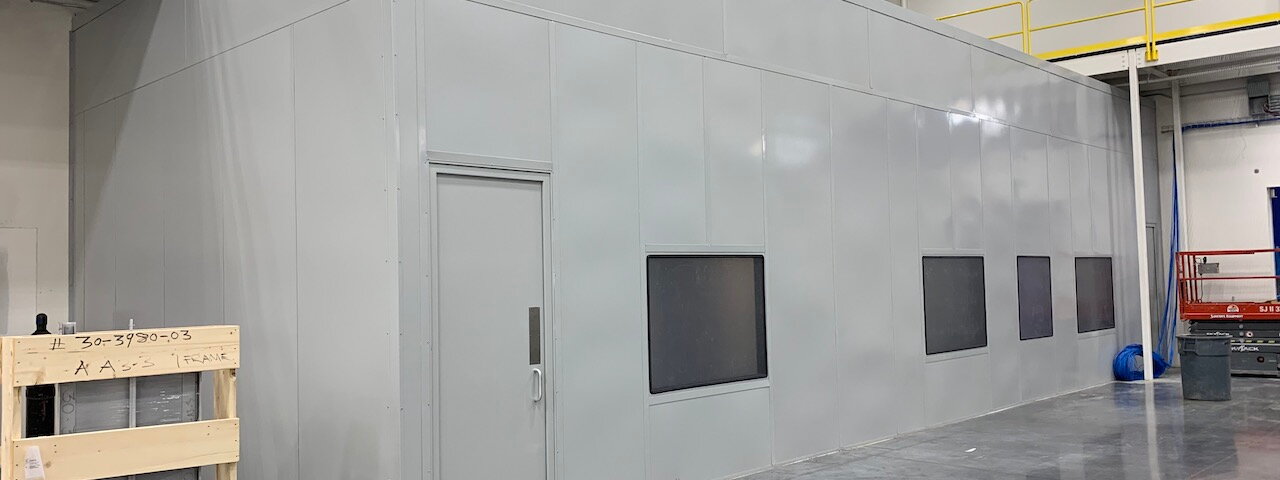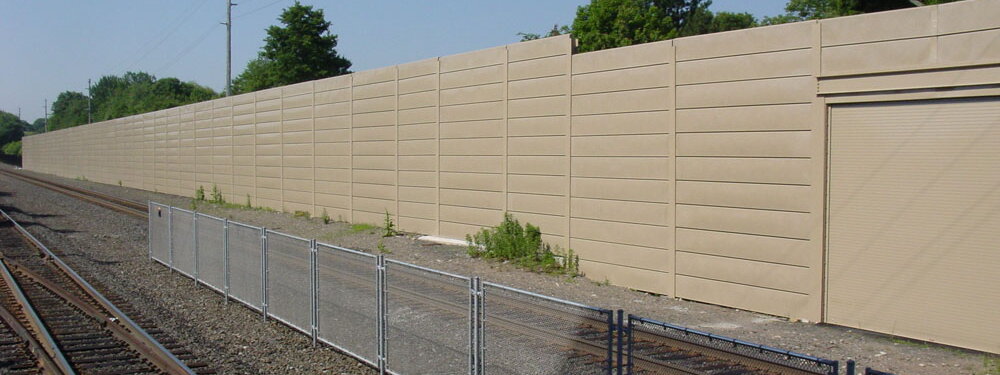Top of the Line Noise Control for Interior and Exterior Problems
Metal noise barrier walls are sound-blocking structures built from acoustically engineered metal panels designed to prevent the transmission of airborne noise. These systems are typically composed of high-mass steel or aluminum outer skins combined with internal insulation or absorptive cores that disrupt, reflect, and absorb sound energy.
These panels are mounted to steel or concrete supports and can be configured as stand-alone barriers, partial enclosures, or integrated into architectural facades. Metal barriers are ideal for both outdoor and indoor use, thanks to their weather resistance, fire safety, and structural durability.
Common uses include enclosing HVAC systems, shielding electrical substations, isolating factory noise, or serving as highway sound walls. Their mass and rigidity make them particularly effective for controlling low-frequency noise from engines, compressors, transformers, and industrial processes.
Key Benefits of Metal Barrier Walls
Exceptional Sound Blocking: Metal barriers can block up to 60 dB of noise, especially in low-frequency ranges where traditional absorptive materials struggle. This makes them ideal for applications like mechanical plant enclosures or transportation-related sound barriers.
Long-Term Durability: Built with corrosion-resistant metals and weatherproof coatings, these barriers hold up in harsh climates and heavy-use environments. They’re designed to perform for decades without degrading, warping, or requiring significant maintenance.
Customizable and Scalable: Our metal noise barrier walls come in various sizes, thicknesses, finishes, and configurations. Panels can be powder-coated, galvanized, or even perforated to match architectural styles or enhance airflow.
Interior and Exterior Use: From rooftop mechanical units to in-plant enclosures around stamping presses or compressors, metal barriers are versatile. They’re fire-rated, pest-resistant, and structurally sound enough for outdoor public spaces and indoor industrial zones alike.
Code and Compliance Friendly: Metal noise walls are engineered to meet local zoning, OSHA, and municipal code requirements. They can also contribute to LEED credits by reducing noise pollution and improving occupant comfort.
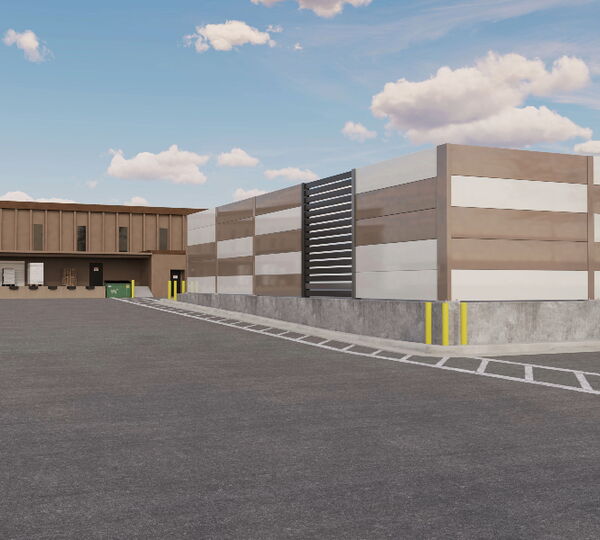

Specifications
Size: Die-cut to fit above 2x2 or 2x4 ceiling tiles, lights, and fixtures
Thickness: 4"or 5"
Weight: 5-6lbs/sqft
STC: Up to 52
NRC: Up to .95
Fire Rating: Class A per ASTM E-84
Color: Prime for Paint, Galvanneal, or Powder Coated
Various Models Available

Composition
Core Material: Sound Absorbing Fiberglass or Mineral Wool
16 Gauge Solid Skin on one side
22 Gauge Perforated Skin on opposite side

Common Applications
- Industrial Facilities
- Mechanical Yards
- Transportation Corridors
- Construction Sites
- Power Generation
- Manufacturing Plants
Related Products
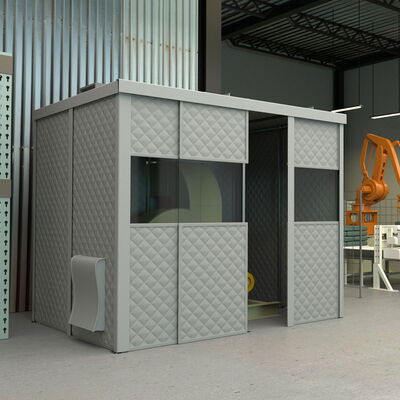
Acoustic Noise Enclosures
Whether shielding noisy machinery, isolating HVAC systems, or protecting exterior equipment, noise enclosures play a crucial role in reducing noise pollution and improving workplace environments.
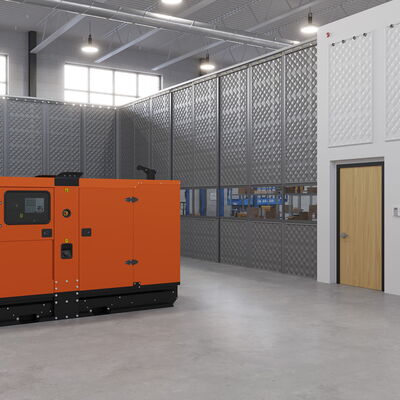
Sound Barrier Composite Panels
Designed to deliver the combined benefits of noise blocking and sound absorption, sound barrier composite panels are ideal for industrial facilities, mechanical rooms, manufacturing plants, commercial buildings, and construction sites..
Frequently Asked Questions
A: Metal noise barrier walls should be used in any environment where controlling loud, intrusive sound is essential for safety, comfort, or regulatory compliance—particularly in situations where low-frequency noise like that from HVAC systems, heavy machinery, or traffic is present. They are especially beneficial when a long-term, durable solution is required rather than a temporary fix. These barriers are ideal for manufacturing plants, data centers, compressor stations, substations, rail corridors, and even entertainment venues. Their robust construction ensures reliable performance even under continuous exposure to vibration, weather, and high-decibel output.
A: The installation process begins with careful planning and site preparation. Structural support posts are anchored into a concrete foundation or mounted onto pre-existing structural steel frameworks. Prefabricated acoustic metal panels are then secured between these posts using engineered mounting brackets or fasteners. The system is modular, allowing for scalable installations in both horizontal and vertical directions. Installation can be carried out with minimal disruption to ongoing operations and can be customized to include integrated doors, viewing panels, ventilation cutouts, and access hatches. Additional absorptive cladding may be applied on one or both sides when required.
A: Properly engineered metal noise barrier walls can achieve sound reduction levels of up to 60 decibels. The actual performance depends on a combination of factors including wall height, panel density, construction quality, and distance from the noise source to the receiver. In some industrial applications, walls can be tailored to provide focused attenuation of specific troublesome frequencies, particularly in the 63 Hz to 250 Hz range where many barriers struggle. In outdoor environments, tall perimeter walls combined with strategic placement can help contain or redirect noise over long distances.
A: Yes. Metal barrier systems are designed to withstand the toughest environmental conditions, including heavy rain, snow, salt spray, industrial pollutants, and UV exposure. Galvanized steel and powder-coated aluminum are common material choices, offering rust resistance and structural stability over time. Optional protective finishes further increase longevity and reduce maintenance needs, even in coastal or high-humidity zones. Drainage systems and expansion joints can be built into large installations to manage water runoff and thermal movement.
A: Metal noise barriers primarily function as sound blockers due to their mass and rigidity, which reflect and prevent airborne sound from passing through. However, when outfitted with absorptive materials on one or both sides—such as perforated face sheets backed with fiberglass or mineral wool—they can also reduce noise reflections and standing waves within enclosed spaces. This dual-action configuration is ideal for barrier walls placed near sound sources or within reverberant interiors.
A: Yes. At DDS Acoustical Specialties, we offer complete design flexibility. Panels can be manufactured in custom dimensions and thicknesses to meet acoustic targets and spatial constraints. Finish options include various colors, corrosion-resistant coatings, textured surfaces, or decorative facades to match architectural surroundings. We can integrate sound-absorbing layers, perforated faces, or absorptive quilted backings depending on project needs. Additional elements like signage mounts, lighting brackets, and removable access panels can be added to support multi-functional design.
A: Metal noise barriers are low-maintenance by design. Periodic inspections should be scheduled to check for physical damage, surface corrosion, and fastener integrity. Cleaning with non-abrasive detergents can help preserve finishes, especially in dusty or corrosive environments. Recoating or touch-ups may be needed after prolonged exposure, but well-installed systems typically remain effective for decades. Optional anti-graffiti coatings are available for public-facing walls to simplify upkeep in urban environments.

